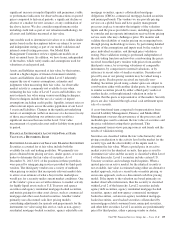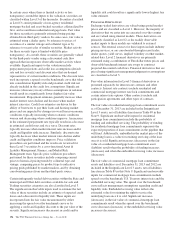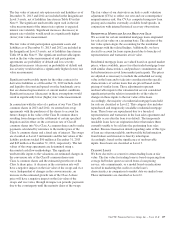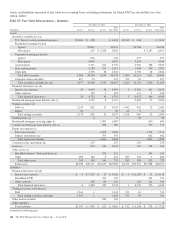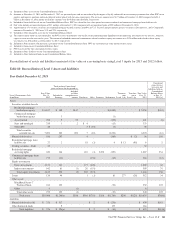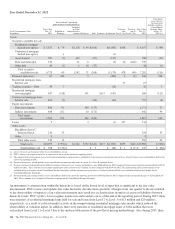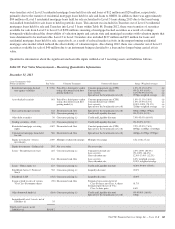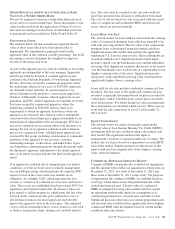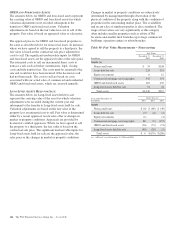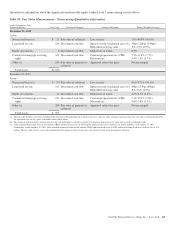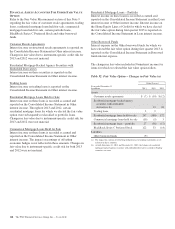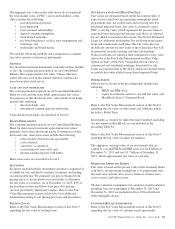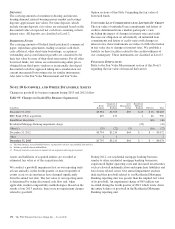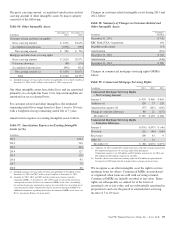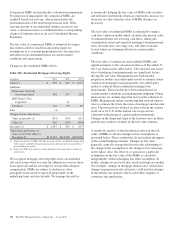PNC Bank 2013 Annual Report Download - page 183
Download and view the complete annual report
Please find page 183 of the 2013 PNC Bank annual report below. You can navigate through the pages in the report by either clicking on the pages listed below, or by using the keyword search tool below to find specific information within the annual report.O
THER
F
INANCIAL
A
SSETS
A
CCOUNTED FOR AT
F
AIR
V
ALUE ON A
N
ONRECURRING
B
ASIS
We may be required to measure certain other financial assets
at fair value on a nonrecurring basis. These adjustments to fair
value usually result from the application of lower-of-cost-or-
fair value accounting or write-downs of individual assets due
to impairment and are included in Table 90 and Table 91.
N
ONACCRUAL
L
OANS
The amounts below for nonaccrual loans represent the fair
value of those loans which have been adjusted due to
impairment. The impairment is primarily based on the
appraised value of the collateral or LGD percentage. The LGD
percentage is used to determine the weighted average loss
severity of the nonaccrual loans.
As part of the appraisal process, persons ordering or reviewing
appraisals are independent of the asset manager. Appraisals
must be provided by licensed or certified appraisers and
conform to the Uniform Standards of Professional Appraisal
Practice. For loans secured by commercial properties where
the underlying collateral is in excess of $250,000, appraisals
are obtained at least annually. In certain instances (e.g.,
physical changes in the property), a more recent appraisal is
obtained. Additionally, borrower ordered appraisals are not
permitted, and PNC ordered appraisals are regularly reviewed.
For loans secured by commercial properties where the
underlying collateral is $250,000 and less, there is no
requirement to obtain an appraisal. In instances where an
appraisal is not obtained, the collateral value is determined
consistent with external third-party appraisal standards by an
internal person independent of the asset manager. PNC has a
real estate valuation services group whose sole function is to
manage the real estate appraisal solicitation and evaluation
process for commercial loans. All third-party appraisals are
reviewed by this group, including consideration of comments/
questions on the appraisal by the reviewer, customer
relationship manager, credit officer, and underwriter. Upon
resolving these comments/questions through discussions with
the third-party appraiser, adjustments to the initial appraisal
may occur and be incorporated into the final issued appraisal
report.
If an appraisal is outdated due to changed project or market
conditions, or if the net book value is utilized, management
uses an LGD percentage which represents the exposure PNC
expects to lose in the event a borrower defaults on an
obligation. Accordingly, LGD, which represents the loss
severity, is a function of collateral recovery rates and loan-to-
value. Those rates are established based upon actual PNC loss
experience and external market data. In instances where we
have agreed to sell the property to a third party, the fair value
is based on the contractual sales price adjusted for costs to
sell. In these instances, the most significant unobservable
input is the appraised value or the sales price. The estimated
costs to sell are incremental direct costs to transact a sale such
as broker commissions, legal, closing costs and title transfer
fees. The costs must be essential to the sale and would not
have been incurred if the decision to sell had not been made.
The costs to sell are based on costs associated with our actual
sales of commercial and residential OREO and foreclosed
assets, which are assessed annually.
L
OANS
H
ELD FOR
S
ALE
The amounts below for loans held for sale include the carrying
value of commercial mortgage loans which are intended to be
sold with servicing retained. The fair value of the commercial
mortgage loans is determined using discounted cash flows.
Significant observable market data includes the applicable
benchmark U.S. Treasury interest rates. These instruments are
classified within Level 3. Significant unobservable inputs
include a spread over the benchmark curve and the embedded
servicing value. Significant increases (decreases) to the spread
over the benchmark curve would result in a significantly lower
(higher) carrying value of the assets. Significant increases
(decreases) in the embedded servicing value would result in
significantly higher (lower) carrying value.
Loans held for sale also includes syndicated commercial loan
inventory. The fair value of the syndicated commercial loan
inventory is primarily determined based on prices provided by
a third-party vendor. The third-party vendor prices are based
upon dealer quotes. For nonrecurring fair value measurements,
these instruments are classified within Level 2. There were no
loans held for sale categorized as Level 2 at December 31,
2013 or 2012.
E
QUITY
I
NVESTMENTS
The amounts below for equity investments represent the
carrying value of Low Income Housing Tax Credit (LIHTC)
investments held for sale calculated using a discounted cash
flow model. The significant unobservable input is
management’s estimate of required market rate of return. The
market rate of return is based on comparison to recent LIHTC
sales in the market. Significant increases (decreases) in this
input would result in a significantly lower (higher) carrying
value of the investments.
C
OMMERCIAL
M
ORTGAGE
S
ERVICING
R
IGHTS
Commercial MSRs are periodically evaluated for impairment
and the amounts below reflect an impairment of three strata at
December 31, 2013, two strata at December 31, 2012 and
three strata at December 31, 2011, respectively. For purposes
of impairment, the commercial MSRs are stratified based on
asset type, which characterizes the predominant risk of the
underlying financial asset. The fair value of commercial
MSRs is estimated by using a discounted cash flow model
incorporating unobservable inputs for assumptions as to
constant prepayment rates, discount rates and other factors.
Significant increases (decreases) in constant prepayment rates
and discount rates would result in significantly lower (higher)
commercial MSR value determined based on current market
conditions and expectations.
The PNC Financial Services Group, Inc. – Form 10-K 165


